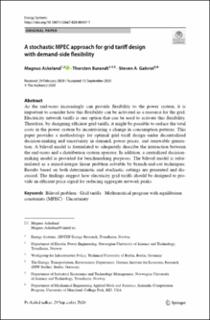A Stochastic MPEC Approach for Grid Tariff Design with Demand-Side Flexibility
Peer reviewed, Journal article
Published version
Permanent lenke
https://hdl.handle.net/11250/2684862Utgivelsesdato
2020Metadata
Vis full innførselSamlinger
- Publikasjoner fra CRIStin - SINTEF Energi [1649]
- SINTEF Energi [1773]
Originalversjon
10.1007/s12667-020-00407-7Sammendrag
As the end-users increasingly can provide fexibility to the power system, it is important to consider how this fexibility can be activated as a resource for the grid. Electricity network tarifs is one option that can be used to activate this fexibility. Therefore, by designing efcient grid tarifs, it might be possible to reduce the total costs in the power system by incentivizing a change in consumption patterns. This paper provides a methodology for optimal grid tarif design under decentralized decision-making and uncertainty in demand, power prices, and renewable generation. A bilevel model is formulated to adequately describe the interaction between the end-users and a distribution system operator. In addition, a centralized decisionmaking model is provided for benchmarking purposes. The bilevel model is reformulated as a mixed-integer linear problem solvable by branch-and-cut techniques. Results based on both deterministic and stochastic settings are presented and discussed. The fndings suggest how electricity grid tarifs should be designed to provide an efcient price signal for reducing aggregate network peaks.

